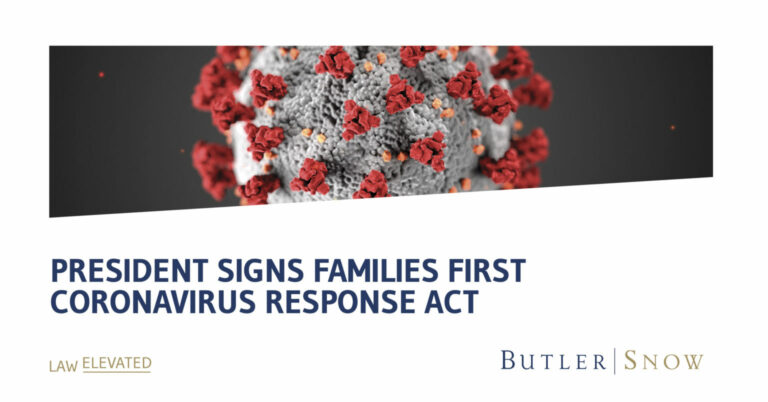President Trump signed into law the economic stimulus bill aimed at curbing the impact of COVID-19 on businesses and individuals. Earlier this week, the U.S. House of Representatives unanimously passed a corrected version of the COVID-19 response bill, H.R. 6201, the Families First Coronavirus Response Act. The U.S. Senate overwhelmingly passed that same bill earlier today. The Act will go into effect no later than 15 days after the date of enactment.
The Act speaks to five distinct areas of relief-1) Free Coronavirus Testing; 2) Food Assistance; 3) Medicaid FMAP rates; 4) Unemployment Aid; and 5) Paid Sick and Medical Leave.
As it pertains to labor and employment matters affecting businesses*:
Emergency Family Leave
Who Qualifies
The Act provides that private-sector employers with fewer than 500 employees, and covered public-sector employers, must provide up to 12 weeks of job-protected FMLA leave for “a qualifying need related to a public health emergency.” Only employees who have been on the payroll for 30 calendar days are eligible for this leave. The Secretary of Labor is also granted authority to draft regulations which will exempt businesses with fewer than 50 employees if the requirements would jeopardize the viability of the business as a going concern. Employers can also exclude healthcare workers and first responders from the leave allowed under this Act.
The definition of “qualifying need” is limited to situations where an employee is unable to work due to the need to care for a minor child if the minor child’s “school or place of care has been closed, or the child care provider of such son or daughter is unavailable, due to a public health emergency.”
Employee Pay
The first 10 days of this emergency FMLA leave can be unpaid, but employers are required to pay employees for the remainder of the leave. The Act requires that the employee be paid for the number of hours the employee would otherwise be scheduled to work at a rate of two-thirds of the employee’s regular rate. The Act caps these payment to individual employees to no more than $200 per day and $10,000 in total. While an employee may elect to utilize vacation, sick, or other personal paid leave, an employee cannot be forced to use paid leave.
Job-Protection
Like regular FMLA leave, an employer must restore employees who utilize emergency FMLA leave to their prior positions or an equivalent position. This job protection, however, does not apply to employers with fewer than 25 employees, if (i) the employee’s position no longer exists following leave due to economic conditions, or (ii) other operational changes caused by a public health emergency (e.g. COVID-19).
Paid Sick Leave
In addition to Emergency Family Leave, the Act also provides paid sick leave.
Who Qualifies
Private-sector employers with fewer than 500 employees, and covered public-sector employers, must provide 80 hours of paid sick time to an employee (of any tenure) who is unable to work (or telework) because: (1) the employee is subject to a federal, state, or local quarantine or isolation order related to COVID-19; (2) the employee has been advised by a health care provider to self-quarantine because of COVID-19; (3) the employee is experiencing symptoms of COVID-19 and is seeking a medical diagnosis; (4) the employee is caring for an individual who is subject to, or advised to, quarantine or isolate; (5) the employee is caring for a son or daughter whose school or place of care is closed, or child care provider is unavailable, due to COVID-19 precautions; or (6) the employee is experiencing substantially similar conditions as specified by the Secretary of Health and Human Services, in consultation with the Secretaries of Labor and Treasury.
Employers may elect to exclude healthcare providers or first responders from this paid leave. The Secretary of Labor is also granted authority to draft regulations which will exempt businesses with fewer than 50 employees if the requirements would jeopardize the viability of the business as a going concern.
Limits on Pay
During paid sick leave, employers are required to pay employees their regular rate of pay or minimum wage, whichever is greater; however, if the leave is to care for a family member, then the employee is entitled to only two-thirds of that amount. The Act places limits on this paid leave to $511 per day or $5,110 in the aggregate where leave is taken for reasons generally related to the employee’s health. The limits on pay are $200 per day and $2,000 in the aggregate where leave is generally related to the care of others, including childcare.
Anti-Retaliation
The Act prohibits an employer from retaliating against any employee who takes leave in accordance with the provisions of the Act. Failure to pay this sick leave will be a violation of the Fair Labor Standards Act similar to a failure to pay minimum wage.
Monetary Relief for Employers
Employers that are required to offer Emergency FMLA or paid sick leave will be eligible for tax-credits in an amount equal to 100% of the qualified sick leave wages paid under this Act. We also expect the Department of Treasury to take some other tax relief actions, as well as actions to allow small businesses to access funds to assist with cash flow problems.
We anticipate a stimulus package aimed at small businesses and industries will be revealed soon.
We are actively monitoring any new legislation and will provide updates as they become available.
*Note: Articles covering the details of the Act’s other provisions can be found here.
